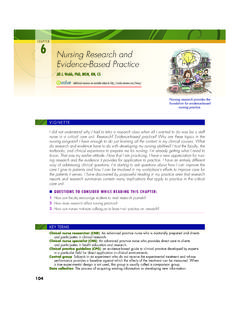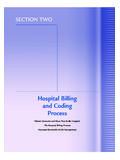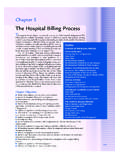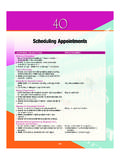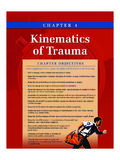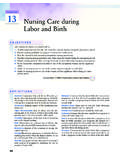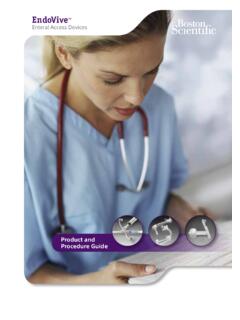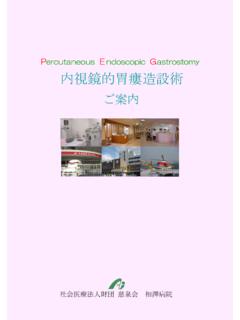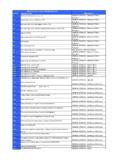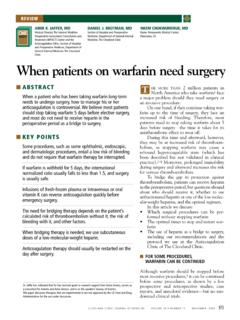Transcription of Complications of Enteral Nutrition - …
1 Complications of Enteral Nutrition21517 Peter L. Beyer, MS, RDENTERAL Nutrition is the preferred route for providingnutrition support when the gastrointestinal (GI) tract isfunctional. Compared with conventional central venousfeeding, Enteral feeding is associated with fewer serious com-plications, is more nutritionally complete, is more effective inmaintaining or restoring host immune response, and takesadvantage of normal physiologic and metabolic processes. Inaddition, delivery of nutrients by way of the GI tract allowsmaintenance of physical and immune-mediated barriers;decreases risk of sepsis; reduces the risk of cholestasis; andstimulates dozens of gut peptides, which affect far more thanthe GI cost of feeding tube placement, administra-tion, equipment, and formula is also considerably less than par- Enteral Nutrition .
2 Most of the Complications associated with Enteral feedingare minor, but some can be quite serious. The incidence andseverity of Complications , however, can be reduced by assess-ment of the patient s clinical status and nutritional needs,careful placement of the feeding tube, monitoring the feedingprocess, and proper selection and advancement of the this chapter, the more common Complications of enteralnutrition are discussed along with guidelines for their preven-tion and treatment. Complications can be categorized in severalways, but we have grouped them under three main headings:(1) problems encountered during the placement of feedingtubes and delivery of Enteral formulas (2) clinical and meta-bolic problems, and (3) nutritional with Initial Placement of FeedingTubesNasogastric and Nasoenteric TubesComplications that can occur during the placement of nasogas-tric or nasoenteric tubes include nasopharyngeal irritation andpain; misplacement of the tube; and in patients who are con-fused or upset, further agitation and combativeness.
3 Thesmaller, softer, and more flexible types of feeding tubes usedtoday can easily coil or kink during placement. Patients whoare alert can swallow small amounts of water to facilitate or other topical anesthetic is sometimesused to reduce patient When the patient cannotparticipate in tube placement, a stylet can be used to stiffen thetube or the small tube can be attached to or passed inside alarger one to be withdrawn after placement. Perforation of thelung, esophagus, stomach, or small intestine can result fromusing stylets, rigid tubes, or endoscopes to place, clear, oradvance the feeding ,8 Intracranial entry has beenreported in cranial trauma and nontrauma ,10 Fortunately, perforation rarely occurs and can be prevented byenlisting the patient s cooperation, using a lubricated tube tofacilitate passage, and stopping advancement of the tube ifresistance is encountered.
4 Newer tubes are now available thatprevent the stylet from exiting the distal end of the tubes are inadvertently placed into the lung, patientsusually demonstrate some form of respiratory distress (cough-ing, shortness of breath, inability to speak), but some patientsnever exhibit symptoms. In some cases patients may not beable to communicate or may not exhibit a normal reaction torespiratory insults. Initial position of nasogastric/nasoenterictubes is verified automatically when placed by endoscope,fluoroscopy, sonography, or electromyograms. These methodsare also considered the best ways to verify feeding tube posi-tion after traditional placement, but they may not be availableor practical for frequent use at the bedside or home bedside methods are used to verify tube placement,but because no single method is foolproof, at least two tech-niques are usually recommended.
5 (1) asking the patient tospeak, (2) auscultation (listening at the abdomen for gurgling while air is introduced into the tube) or (3) withdrawing fluid tocheck for volume, appearance, acid pH, or the presence ofbilirubin or digestive enzymes11,12 Another technique beingevaluated is the use of a colorimetric sensor for the presence ofcarbon dioxide, which would indicate that the tube is in for frequency of checking the position ofenteral tubes vary, depending on institutional protocol. Becausefeeding tubes may become displaced, coiled, or kinked, someinstitutions recommend daily verification of placement whencontinuous feedings are used and before starting bolus or inter-mittent feeding.
6 Common nursing practice is to color tube feed-ings with blue food coloring to differentiate the presence of thefeeding from other fluids and secretions. Another techniqueused to determine aspiration of tube feeding includes use ofglucose-oxidase strips to detect presence of sugars in the sensitivity and specificity of both techniques inproving presence of tube feeding in lung aspirates appears to bemarginal, and the blue dye used may not always be features, such as presence of fever, purulent aspirates,or radiographic evidence of pulmonary infiltrates, can be usedto determine of feeding tubes into the duodenum or jejunumhas been recommended in persons at increased risk of refluxand aspiration and in patients who may have impaired gastricseveral Complications related to the surgical procedure, anes-thesia, the type of tubes employed, or establishing and main-taining the insertion site.
7 Published complication rates varywidely, from 2% to greater than 50%, with an overall compli-cation rate of approximately 15%.7,18,19 The most commoncomplications associated with open gastrostomy feeding tubeplacement include local wound infection, catheter leakage,and tube dislodgment. Wound dehiscence, peritonitis, aspira-tion, bleeding, and GI obstruction are more serious but lessfrequent ,18 Laparoscopic placement of gastrostomy and jejunostomymay result in many of the same Complications as surgical gas-trostomy tube placement. Laparoscopic gastrostomies andjejunostomies are usually less invasive and result in less tissuetrauma and scarring.
8 Jejunal placement of a large intraluminalballoon, bumper, or T-tube in some cases can result in ahigher incidence of obstruction because the lumen of thejejunum is considerably smaller than the stomach. If the loop ofjejunum is not immobilized during the procedure, risk ofvolvulus may also be increased. Feeding into the jejunum alsorequires more caution in the rate and concentration of enteralformulas, and tube placement too far into the jejunum may alsoincrease risk of GI distress. Needle Catheter JejunostomyNeedle catheter jejunostomy is a placement technique usedduring abdominal ,20A small catheter is placed intothe jejunum over a wire placed via needle puncture through theabdominal wall.
9 Because the catheter is small, placementresults in less trauma, and consequently is less likely to causefistula, bowel obstruction, or volvulus than other jejunostomytechniques. It may also be removed more easily than mostfeeding devices. Because of the small tube size (5 to 6 Fr),clogging is more common, unless lower viscosity feedings areused and tubes are irrigated appropriately. Replacement of dis-lodged tubes may also be more Associated with PercutaneousEndoscopic Gastrostomy, Gastrojejunostomy,and Direct Endoscopic JejunostomyPercutaneous endoscopic gastrostomy (PEG) is a type of tubeplacement performed with the aid of an endoscope.
10 The tube isplaced by one of several push techniques (abdominal wallpunctured from outside the stomach) or pull techniques (wallof the stomach and abdomen punctured from inside thestomach). The tube is normally secured on the inside of thestomach/jejunum by a balloon, collar, or T-tube and on theoutside by a flange, button, or collar to prevent movement andleakage of the tube. Newer techniques and equipment haveallowed endoscopic placement of tubes orally or nasoenteri-cally into the stomach or the jejunum (PEG/J), or direct place-ment into the ,19,21-25 Placement and use of PEG/Jtubes are associated with complication rates ranging from lessthan 10% to greater than 30%, depending on the type of appa-ratus, the patient s clinical status, and the experience of theclinicians who place the tube and care for the placed gastrostomies, and PEG/J tubes ingeneral, appear to be superior to surgically placed gastro-stomies and jejunostomies in terms of overall morbidity and216 PART IVPrinciples of Nutrition Supportemptying or upper GI obstruction.
